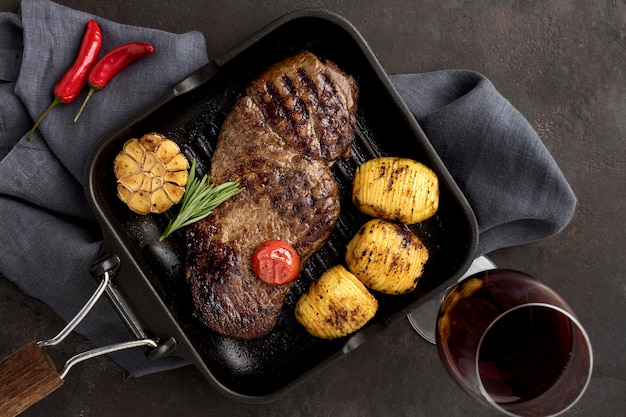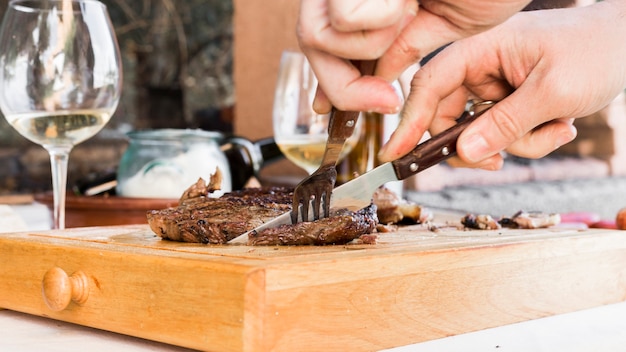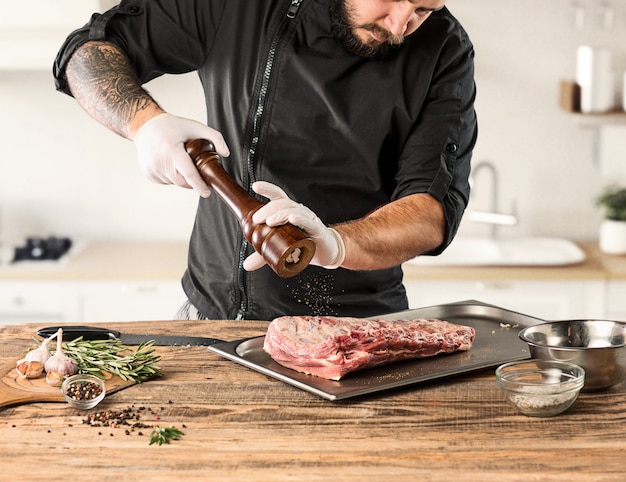(Part 1) The Quest for the Perfect Cut

Choosing the Right Cut for the Job
Let's face it, not all cuts of beef are created equal. Some are best for grilling, while others shine in slow-cooked dishes. For a truly delightful medium-rare steak, you need a cut that's marbled, meaning it has those white streaks of fat running through the meat. Marbling is key to achieving that juicy, melt-in-your-mouth experience because it adds flavor and tenderness.Here are some of my top picks for medium-rare perfection:
- Rib-eye: This is my absolute favorite. It's thick, beautifully marbled, and boasts a rich, buttery flavor that's simply irresistible. It's a true classic for a reason.
- new york strip: Another excellent choice, offering a leaner alternative to the rib-eye. The strip still packs a punch of flavor and is perfect for those who prefer less fat. It's also a good choice for those looking for a slightly more affordable option.
- filet mignon: This is the luxurious choice, delicate and often more expensive. Filet mignon is renowned for its tender, buttery texture and mild flavor. It's a showstopper for special occasions.
- T-bone: This one offers the best of both worlds with its combination of a tender filet mignon and a more flavorful strip steak. It's a crowd-pleaser that satisfies everyone at the table.
- Sirloin: A budget-friendly option that still delivers fantastic flavor and tenderness. Just be sure to choose a thick cut for optimal results.
Preparing Your Steak for Success
Once you've chosen your perfect cut, it's time to prep it. Some people prefer to trim the fat completely, but I find it adds a lot of flavor. So, I usually just trim off any excess fat that might hinder the cooking process.Here's my step-by-step approach to prepping the steak:
- Pat it dry: I like to pat my steak dry with paper towels. This helps create a nice sear and prevents the steak from steaming instead of browning, which can result in a less flavorful and tender steak.
- Season it simply: Salt and pepper are all you really need. I always season my steak generously with kosher salt and freshly ground black pepper. Resist the urge to add a bunch of other seasonings. You want the natural flavor of the beef to shine through. Let those simple seasonings work their magic.
- Let it come to room temperature: This is a crucial step. Letting your steak rest at room temperature allows it to cook more evenly and prevents it from being cold in the center. It's a simple trick that makes a big difference. Leave it out on the counter for 30-45 minutes before cooking.
(Part 2) Mastering the Art of Cooking

Grilling: The Classic Choice
Grilling is a fantastic way to cook a steak, especially for those who love that smoky flavor and beautiful sear. It's the classic method for a reason. Here's what you need to know to grill a perfect medium-rare steak:- Get those grill grates hot: You want your grill to be blazing hot – around 500°F (260°C). If you can only hold your hand just above the grill for a second or two, it's hot enough. You'll know it's ready when you see those flames licking at the grill.
- Oil the grill grates: This is essential for preventing your steak from sticking. I use a little bit of olive oil or vegetable oil.
- Cook for a shorter time than you think: Many people overcook their steaks out of fear. Don't be afraid to cook it for a shorter time. You'll get a juicier, more flavorful steak. Trust the process and the heat!
- Don't move it around too much: Let the steak cook undisturbed for about 3-4 minutes per side. This helps to create a nice crust and prevents the steak from drying out. Just one flip is all you need.
- Use a meat thermometer: This is crucial for achieving that perfect medium-rare cook. Insert the thermometer into the thickest part of the steak. Medium-rare should be around 130°F (54°C). It's the best way to ensure you get it just right.
- Rest it: Let the steak rest for 5-10 minutes before slicing. This allows the juices to redistribute, making for a more tender and flavorful steak. It's a crucial step, even if you're tempted to dig in right away!
Pan-Searing: A Quick and Easy Option
If you don't have a grill or the weather's not cooperating, pan-searing is an excellent alternative. It's a quick and easy way to achieve that beautiful sear and flavorful crust. Here's how to do it right:- Use a cast-iron skillet: A cast-iron skillet is the best choice for pan-searing. It gets incredibly hot and retains heat well, crucial for achieving a perfect sear. The heat is key to developing that crusty exterior.
- Get the pan smoking hot: Heat your pan over high heat until it's smoking hot. You want that sizzling sound as soon as the steak hits the pan. This is what creates that irresistible crust.
- Use a little bit of oil: Just a tablespoon or two of your favorite cooking oil is all you need. Too much oil can make the steak steam instead of sear, so keep it minimal.
- Don't overcrowd the pan: If you're cooking more than one steak, give them plenty of space to cook evenly. Crowding the pan can lead to uneven cooking and a less satisfying outcome.
- Sear for 3-4 minutes per side: Just like grilling, you want to sear the steak for a short period of time on each side to create a crispy crust. Don't overcook!
- Finish in the oven: Once you've seared both sides, you can finish cooking the steak in a preheated oven at 350°F (175°C). This will ensure that the steak cooks evenly throughout and reaches the desired internal temperature.
reverse searing: A More Consistent Result
Reverse searing is a technique that involves cooking the steak slowly at a low temperature before searing it quickly over high heat. It's a great method for achieving a perfectly cooked steak with a beautiful sear and a juicy, tender interior. Here's how it works:- Cook in the oven at a low temperature: Start by preheating your oven to 275°F (135°C). Place your steak on a baking sheet and cook it for 1-2 hours, depending on the thickness of the steak. This slow and gentle cooking process allows the steak to cook evenly throughout.
- Check for doneness: Use a meat thermometer to check the internal temperature of the steak. For medium-rare, you're aiming for 130°F (54°C). Once it reaches the desired temperature, it's ready for the final step.
- Sear over high heat: Once the steak is cooked to your liking, sear it over high heat in a cast-iron skillet or on a hot grill. This final sear adds that beautiful crust and delicious flavor to your steak. It's the finishing touch that elevates the dish.
(Part 3) Mastering the Internal Temperature

The Importance of Temperature
One of the most crucial aspects of cooking the perfect medium-rare steak is understanding internal temperature. A meat thermometer is your best friend in this process. Don't be afraid to use it! It's the most reliable way to ensure your steak is cooked to your exact preference.Here's a breakdown of common steak doneness levels and their corresponding internal temperatures:
| Doneness | Internal Temperature (°F) | Internal Temperature (°C) |
|---|---|---|
| Rare | 125-130 | 52-54 |
| Medium-Rare | 130-135 | 54-57 |
| Medium | 135-140 | 57-60 |
| Medium-Well | 140-145 | 60-63 |
| Well-Done | 145 | 63 |
Beyond the Thermometer: Visual Cues
While the thermometer is a reliable tool, you can also learn to identify the doneness of your steak by its appearance. Here's a handy guide:- Rare: The steak will be red throughout, with a slightly warm center. It will be soft to the touch and have a cool center.
- Medium-Rare: The center of the steak will be pink, with a thin layer of brown around the edges. It will be slightly more firm to the touch.
- Medium: The steak will have a slightly pink center, with a thicker layer of brown around the edges. It will be firm to the touch.
- Medium-Well: The steak will have a slight pink tinge in the center, with a mostly brown interior. It will be very firm to the touch.
- Well-Done: The steak will be brown throughout and very firm to the touch. It will be dry and tough.
(Part 4) Elevating Your Steak Game
Butter-Basted Steak: A Touch of Luxury
Now, we're getting fancy. Butter-basting your steak is a simple trick that elevates it to the next level. It adds a rich, buttery flavor and creates a beautiful, glossy crust. Here's how to do it:- Use unsalted butter: Unsalted butter will give you more control over the saltiness of the steak. You can adjust the salt level to your liking.
- Add flavor to the butter: This is where you can get creative. Add minced garlic, chopped herbs (like rosemary, thyme, or parsley), or even a splash of Worcestershire sauce to your butter. The possibilities are endless!
- Baste the steak during the last few minutes of cooking: This will infuse the steak with flavor and help to create a beautiful crust. It's a simple, yet effective technique.
- Spoon the melted butter over the steak: Once the steak is cooked to your liking, spoon the melted butter over the top. This will add an extra layer of richness and flavor. It's the finishing touch that makes all the difference.
Steak with a Side of Sauce: The Perfect Finish
A delicious sauce can really elevate your steak game. Here are a few of my favorite steak sauce recipes that complement a medium-rare steak beautifully:- Classic Béarnaise Sauce: A rich, creamy sauce made with egg yolks, butter, and herbs, like tarragon and chervil. It's a classic for a reason, adding a touch of elegance to your meal.
- Spicy chimichurri sauce: This Argentinian sauce is made with parsley, oregano, garlic, olive oil, and red pepper flakes. It's a great way to add a kick of heat to your steak, creating a vibrant and flavorful contrast.
- Red Wine Reduction Sauce: A simple yet elegant sauce made with red wine, shallots, and beef broth. It's perfect for a fancy dinner, adding a sophisticated touch to your steak.
(Part 5) Serving with Style
The Art of Resting
Once your steak is cooked to perfection, let it rest for 5-10 minutes before slicing. This allows the juices to redistribute, making for a more tender and flavorful steak. It's a simple step that makes a significant difference in the overall experience.The Perfect Accompaniments
Here are a few classic steak accompaniments that always go down a treat:- mashed potatoes: Creamy, comforting, and always a crowd-pleaser. They offer a perfect counterpoint to the richness of the steak.
- Roasted vegetables: A healthy and flavorful side dish that complements steak beautifully. Try roasted asparagus, Brussels sprouts, or root vegetables like carrots or parsnips.
- Creamed spinach: A rich and decadent side that adds a touch of elegance to your meal. It's a classic pairing that adds another layer of flavor and texture to your plate.
- Asparagus: A light and refreshing side that balances the richness of steak. It's a versatile side that works well with any steak and provides a burst of freshness.
- Garlic bread: A delicious and easy-to-make side that everyone loves. It's a perfect way to soak up those flavorful juices from the steak.
(Part 6) steak storage and Safety
Storing Steak in the Fridge
If you're not cooking your steak right away, it's important to store it properly in the fridge to maintain its freshness and quality. Here's how:- Wrap it tightly: Wrap your steak tightly in plastic wrap or aluminum foil. This will help to prevent it from drying out and absorbing odors from other foods in your fridge.
- Store it on a plate: Place your wrapped steak on a plate or in a shallow container to prevent any juices from leaking onto other food. This will help to maintain the cleanliness of your fridge.
- Keep it in the coldest part of the fridge: The coldest part of your fridge is usually towards the bottom, below the crisper drawers. This is where you want to store your steak to keep it fresh for as long as possible.
- Use it within 3-5 days: Fresh steak is always best, so try to use it within 3-5 days of purchasing it. It's always best to enjoy it fresh!
Thawing Frozen Steak
If you're using frozen steak, it's important to thaw it properly to prevent bacteria growth. Here are a few methods:- Refrigerator thawing: The safest way to thaw a steak is in the refrigerator. Allow at least 24 hours for a 1-inch thick steak to thaw completely. This is the most recommended method for thawing frozen steak.
- Cold water thawing: Place the steak in a sealed plastic bag and submerge it in a bowl of cold water. Change the water every 30 minutes to ensure the water stays cold. This method will take about 1-2 hours for a 1-inch thick steak.
- Microwave thawing: This is the quickest method, but it's not always recommended as it can cook the outer edges of the steak unevenly. Use the defrost setting on your microwave and check the steak frequently to avoid overcooking.
(Part 7) Steak Safety and Handling
food safety is Essential
Always remember to practice good food safety when handling raw meat. Here are some key tips to ensure you're handling your steak safely:- Wash your hands thoroughly: Wash your hands with soap and water for at least 20 seconds before and after handling raw meat. This is a crucial step in preventing the spread of bacteria.
- Use separate cutting boards: Use one cutting board for raw meat and another for vegetables and other foods. This is to prevent cross-contamination and ensure that your prepared food remains safe to eat.
- Don't cross-contaminate: Avoid using the same utensils for raw meat and cooked food without washing them thoroughly in between. Always sanitize your utensils to prevent cross-contamination.
- Cook to the right temperature: Always cook your steak to the recommended internal temperature to kill harmful bacteria. Using a meat thermometer is the best way to ensure your steak is cooked to a safe temperature.
- Refrigerate leftovers promptly: Refrigerate any leftover steak within 2 hours (or 1 hour if the temperature is above 90°F). This will help to prevent bacterial growth and ensure the safety of your leftover steak.
(Part 8) FAQs
What if I overcook my steak?
Don't panic! Even if you overcook your steak, there are ways to salvage it. You can try slicing it thin and using it for fajitas, sandwiches, or a stir-fry. It's not ideal, but it's better than throwing it away.How do I know if my steak is done?
You can use a meat thermometer to check the internal temperature of your steak. Medium-rare should be around 130°F (54°C). You can also learn to identify the doneness of your steak by its appearance and texture.Is medium-rare steak safe to eat?
Yes, medium-rare steak is safe to eat as long as it's cooked properly. The key is to cook it to the recommended internal temperature of 130°F (54°C). This ensures that any harmful bacteria are killed.What's the best way to season my steak?
Salt and pepper is all you really need. I always season my steak generously with kosher salt and freshly ground black pepper. Resist the urge to overdo it with other seasonings. You want to let the natural flavor of the beef shine through. Let the simplicity of those two ingredients work their magic.What's the difference between a rib-eye and a New York Strip?
A rib-eye is a thicker cut with more marbling, while a New York Strip is leaner and has less fat. Both cuts are delicious, but the rib-eye will be more tender and flavorful due to the extra fat. The New York Strip is a great alternative for those who prefer a leaner option.Everyone is watching

Corn on the Cob: The Ultimate Guide to Perfectly Cooked Ears
Healthy MealsAh, corn on the cob. Just the name evokes images of sunny days, barbecues, and that sweet, juicy flavour that ...

Perfect Pork Roast Oven Cooking Time: A Guide to Delicious Results
Healthy MealsThere's something truly satisfying about a perfectly roasted pork. The aroma alone is enough to make your mout...

Ham Cooking Time: How Long to Bake, Smoke, or Boil a Delicious Ham
Healthy MealsAh, ham. It's a classic, isn't it? A real crowd-pleaser, especially around holidays. And when done right, it'...

Scallops: The Ultimate Guide to Perfect Cooking
Healthy MealsAh, scallops. Those delicate, sweet, and utterly delicious morsels of the sea. They hold a special place in my...

Spaghetti Squash: The Ultimate Guide to Cooking and Serving
Healthy MealsRemember that time you saw spaghetti squash at the supermarket, looking all bumpy and strange, and thought, "W...
